How To Fix Bad Posture Neck
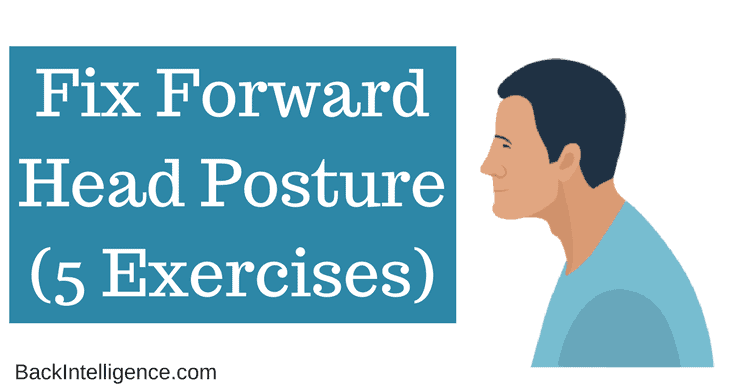
Forward head posture (aka forward neck posture) is an extremely common postural deformity, affecting between 66% and 90% of the population.[1]
This type of posture can make one look unattractive and cause neck pain, upper back pain, along with tension-type headaches, as well as other symptoms (more below).[2]
The good news is with a few simple exercises, posture awareness and workstation modifications and you can start correcting this posture!
How to know if you have forward head posture?
It's simple – do a little test…
- Stand with your back towards a wall with your heels positioned shoulder width apart
- Press your buttocks against the wall and ensure that your shoulder blades are in contact with the wall.
**Squeezing your shoulder blades together can help you get your shoulders into a more neutral position and aligned with the wall.
- Now, check your head position – is the back of your head touching the wall?
- If it's not, you have forward head posture and should do your best to correct it.
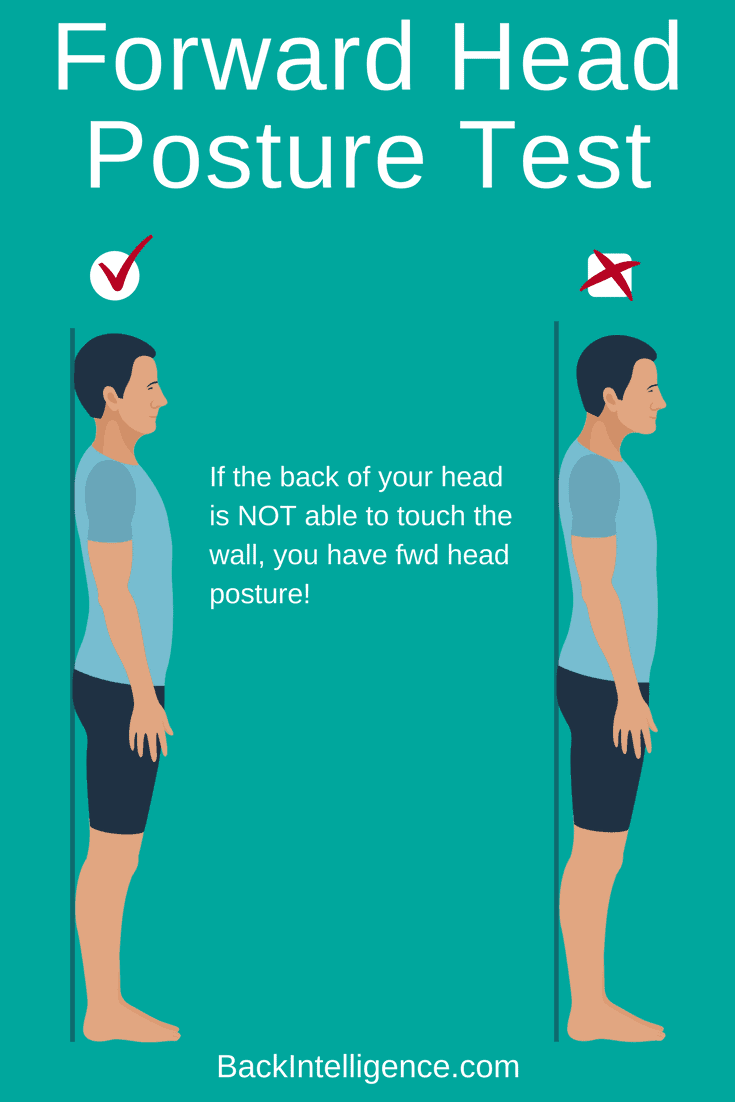
Before we discuss how to fix forward head posture let's dive a little deeper to learn about this condition…
What is Forward Head/Neck Posture?
Forward head posture, sometimes called "Scholar's Neck", "Text Neck", "Wearsie Neck","or "Reading Neck", refers to a posture where the head appears to be positioned in front of the body.
Technically speaking, forward head posture means that the skull is leaning forwards, more than an inch, over the atlas (which is the first vertebrae in your neck).
So what's the problem with this posture? A lot, and it's pretty complicated.
A study published in the Journal of Physical Therapy Science breaks down what happens to the body in individuals with forward head posture:[3]
- The muscles and joints at the front of the neck become weak, while the muscles in the upper back and shoulders get really tight (See muscles affected below).
- The center of gravity of your head shifts forward (anteriorly), which increases the load on your neck – for every inch of forward movement, there is an extra 10 pounds of weight placed on your neck!. This can consequently lead to musculoskeletal, neural, and vascular system dysfunction.
- The changes that occur with forward head posture can lead to persistent and abnormal pressure in the muscles, tissues, and nerves of both the neck and shoulders, which can lead to rounding of shoulders (increased thoracic kyphosis) and herniated discs in an effort to compensate, which results in a higher load being placed on the back and shoulder muscles (Like Trapezius).
- When you combine all of these changes, you could eventually end up with a condition called "tension neck syndrome" – symptoms of this condition can mimic tension headache.
It doesn't stop there… forward head posture doesn't just affect the neck and shoulders; the center of gravity of your entire body is also altered, which affects your torso and every joint in your body.
Your body tries to adapt to these positional changes be altering the balance control mechanisms of the body[3], which actually decreases your ability to balance when engaging in different activities throughout the day, and increases your risk of injury.
Forward Head Posture Symptoms:
- Muscle tightness[3]
- Kyphosis (Excessive rounded shoulders)[3][4]
- Neck tightness/pain[2]
- Dowager's Hump
- Back pain[2]
- Muscle spasms
- Restricted breathing[4][5]
- Poor Balance[3]
- Headaches and migraines[2][4]
- Insomnia
- Trigger Points[4]
- Chronic fatigue
- Numbness and tingling of the arms and hands
- Temporomandibular joint (TMJ) pain[4]
FHP Can Lead To:
- Tension Headaches
- Osteoporosis (and related fractures)
- Poor shoulder mobility[4]
- Cervical (Neck) spine arthritis
- Shoulder blade pain[4]
- Bulging Discs
- Herniated Discs
What causes Forward Head Posture?
Forward head posture is the result of a variety of factors, including:
- In 2 words: "poor posture"[4]
- Weakness of your neck muscles
- Previous neck strains or sprains
- Sleeping with your head elevated too high on pillows
- Frequently sleeping on a sofa with your head propped on the arm rest
- Extended computer use[4][5]
- Extended cellphone use ("Text neck")[4][5]
- Prolonged driving
- Incorrect breathing habits[4]
- Carrying heavy backpacks[4]
- Participating in sports that involve the dominant use of one side of the body (i.e. golf, tennis, hockey, baseball, etc.)
- Certain professions are more at risk due to repetitive movements of the body (i.e. hair stylists, massage therapists, writers, computer programmers, painters, etc.)
Forward Head Posture Muscles Involved:
Forward head posture involves an imbalance of muscles of the neck, shoulders, and upper back.
Weakened muscles include:
- Longus colli (Front part of neck)
- Longus capitis (Front part of neck)
- Infrahyoid and suprahyoid (Front part of neck)
- Rhomboids (Upper back muscles)
- Serratus anterior (Along the side of the ribs connecting to shoulder blade)
- Posterior rotator cuff (Back part of the shoulder)
- Lower trapezius (Mid back)
Tightened muscles include:
- Suboccipitals (Base of the skull)
- Sternocleidomastoid (Side and front of neck)
- Upper trapezius (Upper back)
- Pectoralis minor and major (Chest muscles)
- Levator scapulae (Neck down to shoulder blade)
- Subscapularis (Shoulder blade area)
- Latissimus dorsi (Mid to Lower back)
Recommended Program:
The Complete Posture Fix (With Dr. Oliver) – Fix your fwd head and rounded shoulders posture, ergonomics, get out of pain and increase your mobility.
Learn More
Simple exercises that strengthen and stretch the muscles around the neck, back and shoulders proved to be effective at improving this posture.[6]
Now let's look at the best exercises that you can do from home to combat forward head position once and for all…
5 Forward Head Posture Exercises
Practicing good posture while performing your daily activities, combined with stretching and strengthening the muscles involved in forward head posture, can put you on the right path towards correcting this postural abnormality.
1. Chin Tucks Exercise
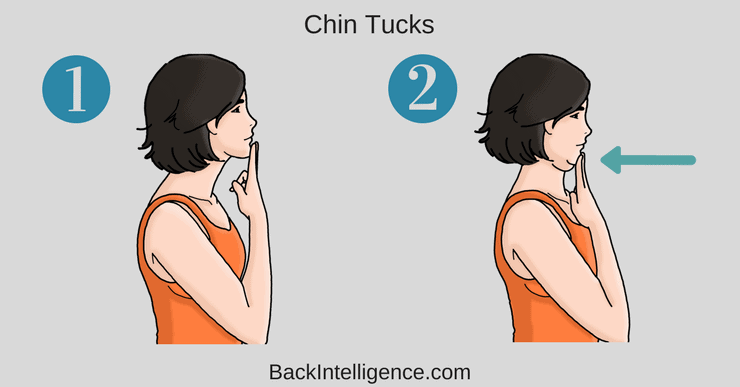
This exercise will activate and strengthen your deep cervical muscles (front of the neck muscles).
- Place 2 fingers at the bottom of your chin.
- Gently tuck your chin in and retract your head backwards. At the same time, use your fingers to keep the chin tucked in the entire time.
- Hold the end position for 3 to 5 seconds.
- Relax your neck for a moment (Let the neck come fwd).
- Aim for 2 to 3 sets of 10 repetitions.
** Your eyes should stay level and you should feel like the back of your neck is lengthening or "pulling up".
2. Neck Flexion (Suboccipital Stretch)
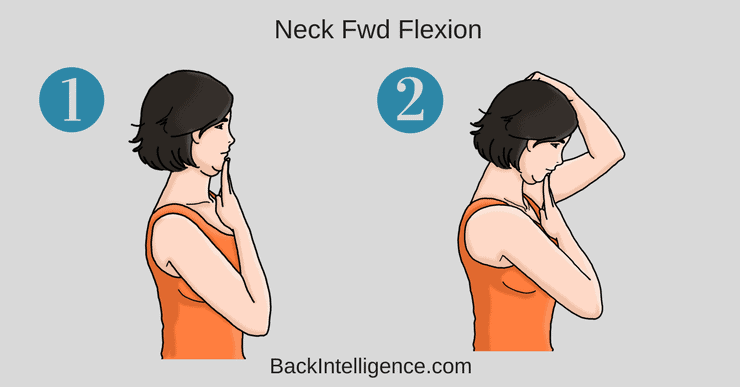
This will stretch the back of your neck muscles including the Suboccipital muscles.
- First, tuck your chin in using 2 fingers of one hand.
- Place your other hand on the back of your head and apply a gentle force down as you pull your head towards your chest.
- When you feel a stretch at the back of your neck, hold the position for 20 to 30 seconds.
- Repeat this stretch 3 times.
** Keep your chin tucked as you do this stretch.
3. Doorway Stretch

This stretch will help to open up your chest and shoulders, which could be very tight.
- Position your elbows and hands in line with a doorframe.
- Step through the door slowly, until you feel a stretch.
- Hold this end position for 20 to 30 seconds before returning to the starting position.
- Repeat this stretch 2-3 times.
** Don't arch you low back as you do this stretch.
4. Shoulder Blade Squeeze (aka Brugger's Relief Position)
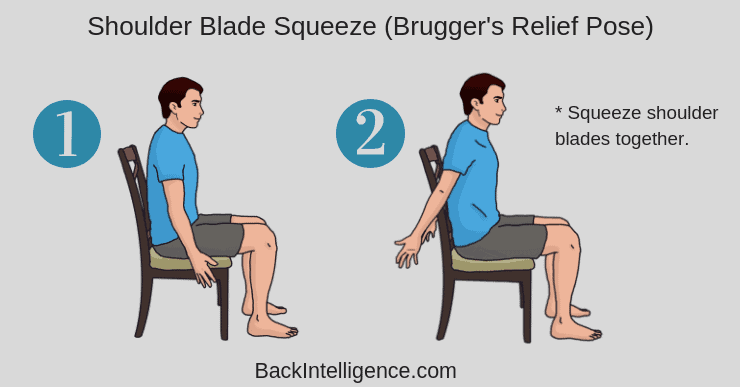
This exercise will activate and strengthen your low and mid back muscles including Low and Mid Trapezius.
- Position your feet and knees slightly wider than your hips, as you sit on a chair.
- Maintain a chin tuck and raise your chest up, allowing your spine to be in a neutral position.
- Rest both of your arms down by your sides.
- Now bring your arms back and externally rotate them so that your thumbs are pointing backwards.
- Hold this position for 5-10 seconds and release.
* Aim for 2-3 sets of 10-15 repetitions.
* Breathe normally as you do these reps.
5. Upper Trapezius Stretch
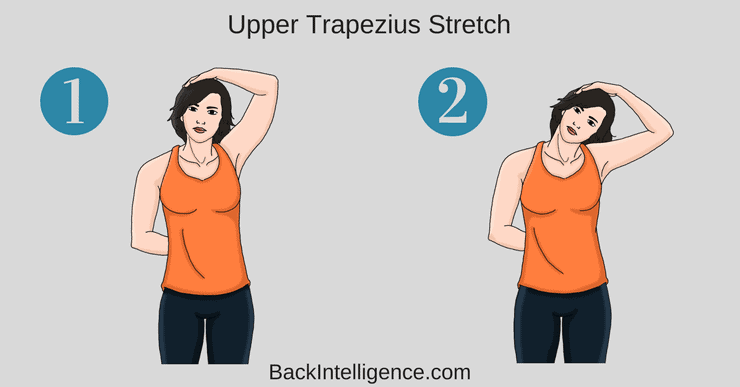
This will stretch out the neck and upper back muscles (Scalene & Upper Trapezius) which can get very tight on individuals with this forward neck syndrome.
- Start either in a standing or seated position.
- Place one of your hands on the opposite side of your head.
- Now bring the head down towards your shoulder.
- Use the hand overhead to press your neck down – to get a deeper stretch (Not too hard).
- Hold for 20-30 seconds and do 2-3 sets.
Get More Details & Exercises In This Video:
Lastly, Proper Ergonomics
If you sit at a computer for extended periods of time, the single most important thing you can do to improve your workstation is to ensure that your computer monitor is positioned properly to allow your neck to remain in a neutral and relaxed position while you work.
- Ensure that the top third of your screen is at eye level
- Your monitor should be between 18 and 24 inches away from your face
**An improperly placed monitor results in straining of your neck and even slouching forward, which will contribute to your forward head position. Check out how to sit properly at a desk here.
Any questions? Leave a comment below
Leon's Thoughts (Founder of Back Intelligence):
I find that just by being more AWARE of my posture through out my day really helps… Every time I notice that my head is protruding forward (when I'm sitting in front of the laptop) I make sure to bring it back… Do you do this? Let us know in the comments area.
Recommended Program:
The Complete Posture Fix (With Dr. Oliver)
Fix your fwd head and rounded shoulders posture, get out of pain and increase your mobility.
Learn More
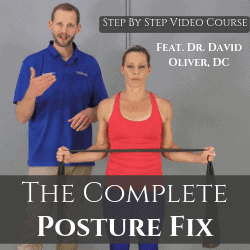
Related:
How to get rid of neck pain
Back pain from sitting
Fix Upper back pain between shoulder blade
How can poor posture result back pain
How to fix rounded shoulders with exercise
Cat Cow Stretch for the spine (video)
Back Intelligence Homepage
Sources:
[1] Kage V, Patel N, Pai M. To compare the effects of deep neck flexors strengthening exercise and McKenzie neck exercise in subjects with forward neck posture: a randomised clinical trial. International Journal of Physiotherapy and Research. 2016;4(2):1451-1458. doi:10.16965/ijpr.2016.117
[2] Griegel-Morris P, Larson K, Mueller-Klaus K, Oatis C. Incidence of Common Postural Abnormalities in the Cervical, Shoulder, and Thoracic Regions and Their Association with Pain in Two Age Groups of Healthy Subjects. Phys Ther. 1992;72(6):425-431. doi:10.1093/ptj/72.6.425
[3] Lee J. Effects of forward head posture on static and dynamic balance control. J Phys Ther Sci. 2016;28(1):274-277. doi:10.1589/jpts.28.274
[4] Singla D, Veqar Z. Association Between Forward Head, Rounded Shoulders, and Increased Thoracic Kyphosis: A Review of the Literature. J Chiropr Med. 2017;16(3):220-229. doi:10.1016/j.jcm.2017.03.004
[5] Jung S, Lee N, Kang K, Kim K, Lee D. The effect of smartphone usage time on posture and respiratory function. J Phys Ther Sci. 2016;28(1):186-189. doi:10.1589/jpts.28.186
[6] Lee D, Nam C, Sung Y, Kim K, Lee H. Changes in rounded shoulder posture and forward head posture according to exercise methods. J Phys Ther Sci. 2017;29(10):1824-1827. doi:10.1589/jpts.29.1824

Licensed chiropractor, DC (Owner of Forme Clinic, Stoney Creek, ON, L8G 1B9)
Dr. Shaina McQuilkie graduated from Brock University in 2004 with a Bachelor of Kinesiology (Honours). She then attended D'Youville College, in Buffalo, New York and obtained her Doctorate of Chiropractic Degree in 2008. After graduating, Dr. McQuilkie practiced in a multi-disciplinary healthcare facility based in Hamilton, Ontario gaining experience treating a variety of musculoskeletal injuries.
Co Authors :

Corrective Exercise Specialist (NASM-CES), Certified Personal Trainer (NASM-CPT), Professional Dancer
As a long time back sufferer Leon found unique methods to alleviate his pain using natural methods including self massage, exercise/stretching and postural habits. He founded Backintelligence.com to empower others to fix their postures and ease their back pain from home.
Set your Author Custom HTML Tab Content on your Profile page
How To Fix Bad Posture Neck
Source: https://backintelligence.com/how-to-fix-forward-head-posture/
Posted by: judemisaid.blogspot.com

0 Response to "How To Fix Bad Posture Neck"
Post a Comment